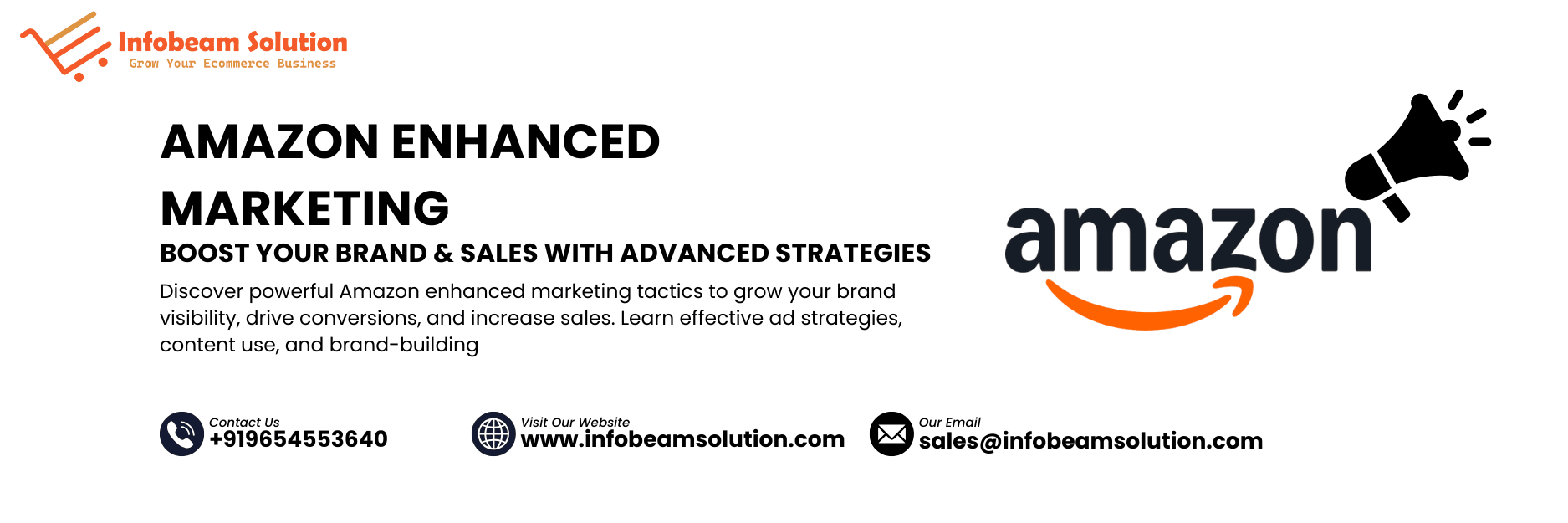Amazon Enhanced Marketing: Boost Your Brand & Sales
Simply having good products isn’t enough on Amazon-strong marketing separates the successful sellers from the rest. Enhanced marketing techniques let you go beyond basic listings or simple ads, helping you amplify visibility, build trust, and ultimately sell more. Here’s how you can use enhanced marketing in 2025 to take your Amazon brand to the next level.

Table of contents
1. What Is Enhanced Marketing on Amazon?
Enhanced marketing refers to advanced promotional strategies that go beyond standard product listings and Sponsored Product ads. It includes things like:
- Sponsored Brands & Display Ads
- Amazon DSP (Demand-Side Platform) campaigns
- A+ or Enhanced Brand Content / Storefronts
- Video content and creative-rich visuals
- Custom promotions, coupons, and high-impact deals
The goal is not just visibility, but memorable branding and conversion lift.
2. Why You Need Enhanced Marketing Now
Enhanced marketing is more crucial than ever due to:
- Intensified competition in many product categories
- Buyers expecting richer content-video, lifestyle photography, brand stories
- Amazon’s algorithms favoring listings with higher engagement and conversions
- Higher ad costs making basic, untargeted sponsorship less efficient
Putting extra effort into marketing gives your brand a differentiator.
3. Key Components of Enhanced Marketing
To do this well, focus on:
- Sponsored Brands & Display Ads
Use these for brand awareness across search results and product detail pages. - Amazon DSP
Reach customers off Amazon, retarget visitors who didn’t buy, or cross-market related products. - Enhanced Brand Content / A+ Content
Add lifestyle images / comparison tables / narrative storytelling to show value beyond specs. - Video & Rich Media
Demonstrations, unboxings, usage videos build trust and often boost conversion. - Brand Storefront
A dedicated page that showcases all your products, categories, and brand identity. - Smart Promotions & Coupons
Promotional timing around seasonal demand, using coupons to reduce friction, bundling complementary products.
4. Strategy to Maximize ROI
Enhanced marketing costs more, so optimizing for ROI is critical:
- Start with clear goals: visibility, traffic, conversion, or repeat purchase.
- Segment your audience: new visitors vs returning, category segments, geography.
- Use analytics to test different creatives, ad formats, and promotional offers.
- Allocate budget to high-return ASINs first; monitor performance metrics such as ACoS, ROAS, conversion rate.
- Keep creatives fresh. Rotate images/videos so audiences don’t get fatigued.
5. Common Pitfalls & How to Avoid Them
Avoid these rookie mistakes:
- Spending heavily on ads without optimizing listings – poor listings waste ad spend.
- Ignoring customer feedback or bad reviews – these damage conversion.
- Using generic or poor visuals – weak creative loses engagement.
- Not analyzing which marketing channels are working – keep tracking & trimming what doesn’t work.
- Overspending on enhanced tools without proper margin buffer – always calculate all associated costs (ads + content + production).
6. Measuring Success
Track these metrics to see if your enhanced marketing is paying off:
| Metric | What to Look For |
|---|---|
| Conversion Rate per ASIN or Campaign | Improved conversion means content, ads are working well |
| Ad Spend Return (ROAS / ACoS) | Are you getting more revenue relative to ad cost? |
| Traffic & Engagement | Impressions, click-through, video views, etc. |
| Brand Store Visits & Storefront Engagement | Are people exploring your brand, category pages? |
| Repeat Purchase Rate / Customer Lifetime Value | Enhanced marketing often helps long-term trust |
Final Thoughts
Enhanced marketing isn’t just about spending more-it’s about spending smart. By combining richer content, targeted advertising, brand storytelling, and continuous testing, you can grow your Amazon brand, improve conversions, and increase sales sustainably.
Start by picking one or two enhanced strategies (say video ads + A+ content), test them on a few products, measure impact, then scale what works.